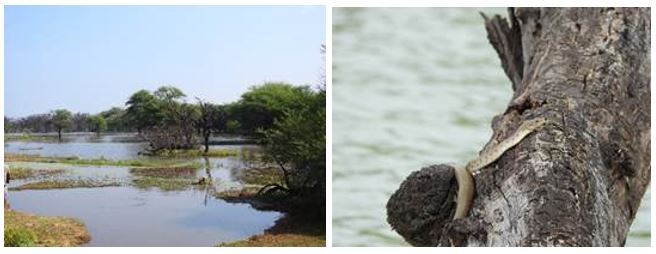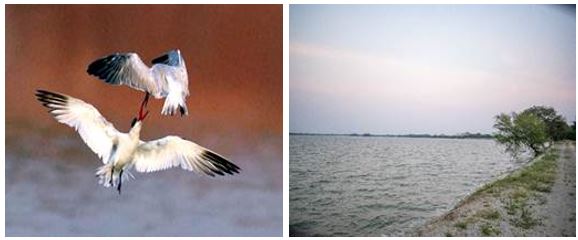

Context
India increases its tally of Ramsar sites (Wetlands of International Importance) to 80 by adding Five more wetlands to the list on the eve of World Wetlands Day 2024 (2nd February)
About
- Three of these sites, Ankasamudra Bird Conservation Reserve, Aghanashini Estuary and Magadi Kere Conservation Reserve are located in Karnataka whereas two, Karaivetti Bird Sanctuary and Longwood Shola Reserve Forest are in Tamilnadu.
- With the addition of these five wetlands to List of Wetlands of International Importance, the total area covered under Ramsar sites is now 1.33 million ha which is an increase of 5,523.87 ha from existing area (of 1.327 million ha).
- Tamil Nadu continues to have maximum number of Ramsar Sites (16 sites) followed by Uttar Pradesh (10 sites).
Ramsar Convention:
- India is one of the Contracting Parties to Ramsar Convention, signed in Ramsar, Iran, in 1971.
- World Wetlands Day (WWD) is celebrated across the globe to commemorate the adoption of this international agreement on wetlands on 2nd February 1971.
- India ratified this Convention on 1st February 1982.
- Earlier in August 2022, India achieved a significant milestone of taking the total number of Ramsar Sites to 75 during the 75th Year of Independence.
- Due to a significant policy push from the Government of India, the number of Ramsar sites has increased from 26 to 80 in the last ten years, of which 38 have been added in the last three years alone.
- The theme of WWD-2024 is ‘Wetlands and Human Wellbeing’ which underscores the critical role wetlands play in enhancing our lives.
- It highlights how wetlands contribute to flood protection, clean water, biodiversity and recreational opportunities, all of which are essential for human health and prosperity.
- This year, the Ministry of Environment, Forest & Climate Change (MoEF&CC), Government of India in collaboration with the Government of Madhya Pradesh, is organizing the national World Wetlands Day event at Sirpur Lake, Indore, a Ramsar site designated in 2022.
List of newly designated Ramsar Sites
|
Sl. No. |
Name of Ramsar Site |
State |
Total area in ha |
|
1 |
Ankasamudra Bird Conservation Reserve |
Karnataka |
98.76 |
|
2 |
Aghanashini Estuary |
Karnataka |
4801 |
|
3 |
Magadi Kere Conservation Reserve |
Karnataka |
54.38 |
|
4 |
Karaivetti Bird sanctuary |
Tamil Nadu |
453.72 |
|
5 |
Longwood Shola Reserve Forest |
Tamil Nadu |
116.007 |
|
|
|
|
5,523.867 |
1. Ankasamudra Bird Conservation Reserve is a humanmade Village Irrigation Tank built centuries back and is spread over an area of 98.76ha (244.04 acre) adjoining the Ankasamudra village. It is an ecologically important wetland, rich in biodiversity, comprising over 210 species of plants, 8 species of mammals, 25 species of reptiles, 240 species of birds, 41 species of fishes, 3 species of frogs, 27 species of butterflies and 32 species of odonates. Over 30’000 waterbirds nest and roost at this wetland, which also supports more than 1% of the biogeographic population of Painted Stork (Mycteria leucocephala) and Black-headed Ibis (Threskiornis melanocephalus).
A view of Ankasamudra Bird CR Checkered keelback at Ankasamudra
2. Aghanashini Estuary, spread over an area of 4801 ha, is formed at the confluence of Aghanashini River with the Arabian sea. The brackish water of the Estuary provides diverse ecosystem services including flood and erosion risk mitigation, biodiversity conservation and livelihood support. The wetland also provides livelihoods to 6000-7500 families by supporting fishing, agriculture, collection of edible bivalves and crabs, shrimp aquaculture, traditional fish farming in the estuarine rice fields (locally known as Gazni rice fields), bivalve shell collection and salt production. Additionally, the mangroves bordering the estuary help to protect the shores against storms and cyclones. The estuary regularly supports over 43,000 counts of over 66 waterbird species and over 1% of the biogeographic population of 15 waterbird species (which includes river tern, oriental darter, lesser black-backed gull, woolly- necked stork, Eurasian oystercatcher and others).
Sanikatta salt pans of Aghanashini
Aghanashini estuary with mangroves blending
3. Magadi Kere Conservation Reserve, is a human-made wetland with an area of nearly 50 hectares which was constructed to store rainwater for irrigation purposes. It is home to over 166 species of birds, of which 130 are migratory. The wetland harbours two vulnerable species, namely Common pochard (Aythya ferina) and River tern (Sterna aurantia) and four near-threatened species, namely Oriental Darter (Anhinga melanogaster), Black-headed Ibis (Threskiornis melanocephalus), Woolly- necked Stork (Ciconia episcopus) and Painted Stork (Mycteria leucocephala). Nearly 8,000 birds visit the site during winter. Magadi Kere is also one of the largest wintering grounds for the Bar-headed goose (Anser indicus) in Southern India. The wetland is a designated Important Bird Area (IBA) and also listed as a priority area for conservation in India.
Panoramic view of Magadi Kere Bar headed goose in Magadi Kere
4. Karaivetti Bird Sanctuary spanning 453.72 ha is one of the largest inland wetlands of Tamil Nadu, and is a significant source of groundwater recharge for the area. Water from the wetland is utilized by the villagers for cultivating agricultural crops such as paddy, sugar cane, cotton, corn, and split red gram. Karaivetti has one of the largest congregations of waterbirds in the State of Tamil Nadu. About 198 species of birds have been recorded here; some of the important visitors being the Bar headed Goose, Pin-tailed duck, Garganey, Northern Shoveler, Common Pochard, Eurasian Wigeon, Common teal and Cotton teal.
Karaivetti Wetland
A pair of Black Winged Stilt mating
5. The Longwood Shola Reserve Forest derives its name from the Tamil word, "Solai", which means a ‘tropical rain forest’. The ‘Sholas’ are found in the upper reaches of the Nilgiris, Anamalais, Palni hills, Kalakadu, Mundanthurai and Kanyakumari in Tamil Nadu. These forested wetlands serve as habitats for the globally endangered Black-chinned Nilgiri Laughing thrush (Strophocincla cachinnans), Nilgiri Blue Robin (Myiomela major), and vulnerable Nilgiri Wood-pigeon (Columba elphinstonii). As many as 14 out of 26 endemic birds species of the Western Ghats are found in these wetlands.
Images of the forested wetlands of the Longwood Shola Forest






